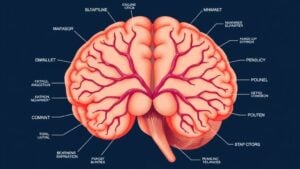The central nervous system consists of two critical components: the brain and the spinal cord. The brain acts as the body’s control center, processing thoughts, emotions, and complex functions like memory and decision-making. Meanwhile, the spinal cord serves as a communication highway, transmitting signals between the brain and the rest of the body while managing reflexes for quick reactions. Together, they coordinate everything from movement to sensation, keeping the body functioning smoothly. Comprehending how these parts work reveals just how intricate and crucial they are to daily life.
The Brain: Command Center of the Body
The brain acts like a supercomputer, controlling everything from thoughts to movement. It processes information through thought processing, allowing decisions, memories, and problem-solving.
Sensory perception lets it interpret sights, sounds, and touches, turning them into meaningful experiences. This organ works nonstop, balancing body functions like breathing and heart rate without conscious effort.
Different regions handle specific tasks—the frontal lobe for reasoning, the occipital lobe for vision. Neurons, the brain’s messengers, fire signals at lightning speed. Stress, sleep, and nutrition affect its performance.
Staying hydrated, eating omega-3-rich foods, and exercising boost brain health. Puzzles and learning new skills keep it sharp. Protecting it from injury is imperative—head trauma can disrupt its delicate wiring.
The brain’s complexity makes it the body’s ultimate command center.
The Spinal Cord: Essential Communication Pathway
The spinal cord serves as the body’s primary communication pathway, transmitting signals between the brain and the rest of the body. Protected by bony vertebrae and meninges, it guarantees safe and efficient message relay.
Its role in reflex arcs allows for rapid, involuntary responses to potential harm.
Structure and Function
Running like a well-protected highway through the spine, the spinal cord serves as the body’s main communication pathway, linking the brain to the rest of the nervous system. During development stages, it forms from the neural tube, growing into a delicate yet crucial structure.
Its structural components include gray matter, shaped like a butterfly, which processes signals, and white matter, which carries messages up and down. Bundles of nerve fibers, called tracts, relay sensory information to the brain and motor commands to muscles. Damage disrupts this flow, causing loss of movement or sensation.
The cord’s segmented design matches spinal vertebrae, ensuring efficient signal transmission. Comprehending its role helps explain how reflexes work and why injuries have lasting effects. Proper care protects this critical link in the nervous system.
Protective Coverings
Though delicate, the spinal cord is shielded by three layers of protective coverings called meninges, which cushion it against injury. These meningeal layers—the dura mater, arachnoid mater, and pia mater—work together to safeguard the spinal cord from physical shocks and infections. Between the arachnoid and pia mater lies cerebrospinal fluid, a clear liquid that acts as a shock absorber and delivers nutrients. This fluid-filled space maintains the spinal cord’s stability and nourishment.
| Meningeal Layer | Function |
|---|---|
| Dura Mater | Tough outer layer for durability |
| Arachnoid Mater | Middle layer with fluid-filled space |
| Pia Mater | Thin inner layer hugging the cord |
Together, these structures create a resilient barrier, keeping the spinal cord safe while allowing seamless communication with the brain.
Reflex Arc Role
Whenever the body needs to react instantly to danger—like pulling a hand away from a hot stove—the spinal cord skips the brain’s input and takes charge through a reflex arc. This rapid response relies on specific reflex arc components and follows a precise reflex arc sequence to protect the body from harm.
- Sensory Input: Nerves detect the danger (like heat) and send signals to the spinal cord.
- Immediate Relay: The spinal cord processes the signal and activates motor nerves without waiting for the brain.
- Muscle Reaction: Muscles contract, pulling the hand away faster than conscious thought permits.
The reflex arc ascertains survival by cutting delays, proving the spinal cord’s role as a quick-decision maker in emergencies.
How the Brain Processes Information
The brain processes information by receiving signals from the senses, sorting them, and forming responses—much like a highly efficient control center. Neural pathways act as communication networks, transmitting data between brain regions. Sensory input travels through these pathways, allowing the brain to interpret sights, sounds, and touches.
Information processing involves filtering relevant details, comparing them to stored memories, and deciding how to react. For example, recognizing a friend’s face relies on visual signals being matched to past experiences. This system works continuously, balancing speed and accuracy.
Over time, repeated actions strengthen these neural pathways, making responses quicker. This delicate balance guarantees the brain adapts while managing countless tasks effortlessly, from solving problems to coordinating movement.
Functions of the Spinal Cord in Movement and Sensation
How does the spinal cord act as the body’s communication superhighway? It connects the brain to the rest of the body, relaying messages for movement and sensation. The spinal cord handles critical impulse transmission, sending touch, pain, and temperature signals to the brain. It also manages motor control coordination, directing muscles to move smoothly.
Sensory Relay: Nerve fibers carry signals from the skin and muscles to the brain, allowing you to feel warmth or a prick.
Reflex Actions: The spinal cord can bypass the brain for quick reactions, like pulling your hand from a hot surface.
Movement Commands: It delivers brain signals to muscles, ensuring coordinated actions like walking or grabbing objects.
Without the spinal cord, the brain couldn’t receive or send pivotal information, disrupting daily life. Its role is essential for both safety and smooth motion.
Key Structures Within the Brain
Several key structures in the brain work together to control everything from thoughts and emotions to movement and memory. The cerebrum, with its folded gray matter composition, handles higher functions like reasoning and language.
The cerebellum, located at the back, coordinates balance and fine motor skills. Deeper structures like the thalamus relay sensory signals, while the hippocampus plays a pivotal role in memory formation. Neurological development shapes how these regions grow and connect, influencing cognitive abilities and behavior.
The brainstem regulates critical functions such as breathing and heart rate, ensuring survival. Each structure’s unique role contributes to overall brain function, making it the command center of the body. Comprehension of these parts helps explain how the brain processes information and adapts over time.
Protective Layers Surrounding the CNS
Though the brain and spinal cord are delicate, nature provides layers of protection to shield them from harm. These safeguards include specialized membranes and structures designed to absorb shocks and prevent damage.
- Membranes surrounding brain (meninges): Three layers—dura mater, arachnoid mater, and pia mater—wrap the brain, cushioning it against impacts.
- Layers protecting spinal cord: The same meningeal layers extend down the spine, with cerebrospinal fluid acting as a shock absorber.
- Bony armor: The skull and vertebrae form a hard outer shell, deflecting physical trauma.
Together, these defenses create a secure environment for the central nervous system, ensuring it functions without disruption. Comprehension of these protective layers highlights how the body prioritizes safety for its most critical structures.
Role of Neurons in the Central Nervous System
Neurons serve as the building blocks of the central nervous system, transmitting signals that control everything from movement to thought. These specialized cells communicate via neuron signaling pathways, where electrical impulses travel along axons to reach synapses.
At these junctions, neurotransmitter release occurs, allowing messages to jump to the next neuron. This process guarantees seamless coordination between body functions and brain commands. Neurons also adapt to repeated stimuli, fortifying connections for faster responses.
Damage or disruption in these pathways can impair movement, memory, or senses. Comprehension of neuron function helps explain how learning and habits form. Each neuron works like a tiny messenger, either exciting or inhibiting signals to maintain balance.
Their precise communication keeps reflexes sharp and thoughts clear.
How the Brain and Spinal Cord Work Together
- Signal Transmission: The brain sends instructions through the spinal cord to muscles, enabling precise actions like walking or grasping.
- Reflex Responses: The spinal cord can bypass the brain for quick reactions, like pulling a hand from a hot surface.
- Sensory Feedback: Nerves relay touch, pain, or temperature data to the brain via the spinal cord, creating awareness.
This partnership keeps the body responsive and agile, blending conscious control with automatic reflexes for survival.
Common Disorders Affecting the CNS
Disorders affecting the central nervous system (CNS) can disrupt brain function, spinal cord communication, or both. Brain-related diseases, such as strokes or tumors, often impair cognitive or motor abilities, while spinal cord injuries could lead to paralysis or sensory loss.
Neurodegenerative conditions, like Parkinson’s or Alzheimer’s, progressively damage nerve cells, deteriorating over time.
Brain-Related Diseases
While the brain acts as the body’s command center, things sometimes go wrong, leading to disorders that disrupt how it works. Brain-related diseases can affect memory, movement, and daily life.
- Alzheimer’s disease: A progressive disorder causing memory loss, confusion, and difficulty with thinking. It worsens over time, making even simple tasks hard.
- Parkinson’s disease: This affects movement, causing tremors, stiffness, and slow movements. It happens when brain cells that control motion break down.
- Epilepsy: Sudden electrical bursts in the brain lead to seizures, which can range from mild to severe.
These conditions often stem from aging, genetics, or brain cell damage. Initial signs include forgetfulness, shaky hands, or sudden muscle jerks. While treatments can help manage symptoms, there’s no cure yet for many brain diseases.
Spinal Cord Injuries
The spinal cord, a delicate bundle of nerves running down the back, plays a key role in sending messages between the brain and body, but injuries to it can dramatically alter how these signals travel. Damage often results from trauma like car accidents, falls, or sports injuries, leading to partial or complete loss of movement and sensation below the injury site. Symptoms may include muscle weakness, numbness, or paralysis.
While some people experience incomplete recovery, rehabilitation strategies like physical therapy, assistive devices, and occupational therapy can improve function. Prompt intervention is crucial, as tailored exercises help retrain the nervous system. Emotional support also plays a big role in recovery, as adjusting to life with limited mobility takes time and patience.
Neurodegenerative Conditions
As the brain and spinal cord gradually lose function over time, neurodegenerative conditions disrupt the body’s ability to move, ponder, or even recall. These disorders often stem from protein misfolding, where harmful clumps form in nerve cells, or neuroinflammation, where the immune system mistakenly attacks healthy brain tissue.
Alzheimer’s disease – Memory fades as tangled proteins and plaques damage brain cells.
Parkinson’s disease – Movement slows due to the loss of dopamine-producing neurons.
ALS (Lou Gehrig’s disease) – Muscles weaken as motor neurons degenerate.
Symptoms vary but often include tremors, confusion, or muscle stiffness. While there’s no cure, treatments like physical therapy or medications can ease discomfort. Research focuses on slowing progression by targeting protein buildup and calming inflammation. Timely detection improves quality of life, so noticing small changes matters. Support from loved ones helps navigate these challenging conditions.
Conclusion
The central nervous system acts like a high-speed network, processing information faster than the blink of an eye—literally. In just one millisecond, a single neuron can send signals up to 268 miles per hour. Without this rapid communication, even the simplest movements, like lifting a cup, would feel sluggish. Maintaining this system healthy guarantees smooth coordination between thoughts and actions, reinforcing how crucial the brain and spinal cord are to everyday life.





